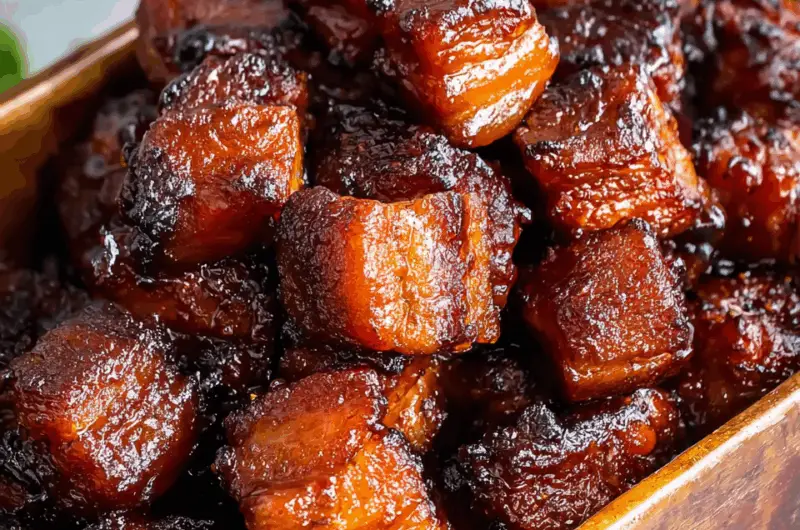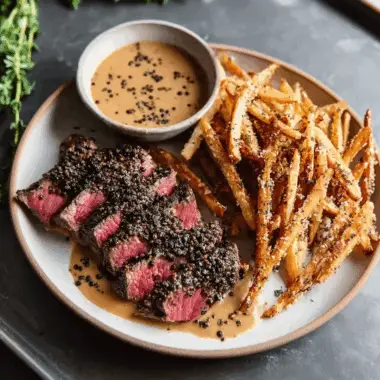These Pork Belly Burnt Ends are a mouthwatering treat, with tender, flavorful meat on the inside and a crispy, caramelized exterior. This recipe uses a simple oven method, making it easy to achieve the delicious, sticky texture of traditional burnt ends without the need for a smoker. The pork belly is slow-cooked, coated in barbecue sauce, and finished with a touch of lemony tang from apple cider vinegar. Perfect for a rich, savory weeknight meal.
Full Recipe:
Ingredients
-
5 ½ lbs pork belly, cubed or sliced
-
1 cup barbecue sauce (your favorite style)
-
3 tablespoons smoked paprika
-
2 tablespoons coarse sea salt
-
2 tablespoons black pepper
-
2 tablespoons apple cider vinegar (for spritzing)
Directions
-
Prepare the Oven and Season the Pork Belly:
-
Preheat the oven to 275°F (135°C). Grease a baking sheet rack with cooking spray to prevent sticking.
-
Toss the cubed pork belly with smoked paprika, sea salt, and black pepper, ensuring each piece is fully coated.
-
-
Bake the Pork Belly:
-
Place the seasoned pork belly on the greased rack with the fat side facing up. Bake for 3 hours, spritzing with apple cider vinegar every hour to keep the pork moist.
-
-
Coat with BBQ Sauce:
-
After 3 hours, transfer the pork belly to a deep baking pan and toss it with your BBQ sauce. Return the pork belly to the oven and bake for an additional 30 minutes.
-
-
Rest and Serve:
-
After baking, let the pork belly rest for 15-20 minutes. Serve warm and enjoy the tender, caramelized flavors!
-
Nutrients
-
Calories: ~7000-7500 kcal (for the entire recipe)
-
Protein: 500-550g
-
Fat: 550-600g
-
Carbohydrates: 150-200g
The Allure of Pork Belly Burnt Ends
What makes Pork Belly Burnt Ends so irresistible? It’s all about the perfect balance of textures and flavors. The slow cooking process allows the pork belly to become incredibly tender, while the fat melts into the meat, ensuring every bite is juicy and flavorful. The exterior gets beautifully crispy and caramelized, thanks to the combination of the seasonings and barbecue sauce, creating that signature burnt end texture.
Unlike traditional smoked burnt ends, this oven method is not only easier but also results in a similar level of tenderness and crispiness. Pork belly is naturally marbled with fat, which helps keep the meat juicy and ensures a rich mouthfeel. The caramelized edges provide the perfect crunch, and the barbecue sauce adds that familiar tangy-sweet flavor that makes these burnt ends so addictive.
Whether you’re a fan of smoky barbecue flavors or just love the richness of slow-cooked pork, this dish offers the best of both worlds. It’s a versatile recipe that can be served as an appetizer, main dish, or even a decadent snack for your next gathering.
The Role of Pork Belly in This Dish
Pork belly is the ideal cut of meat for this recipe because of its high fat content, which renders down during cooking, infusing the meat with flavor and keeping it moist. This cut of pork is known for its tender texture and rich, melt-in-your-mouth quality, making it the perfect base for burnt ends. The fat also helps create a beautiful, crispy crust when baked, which is one of the key characteristics of traditional burnt ends.
Pork belly is often used in a variety of culinary traditions worldwide, and its rich flavor makes it a great choice for slow-cooking methods. It has a slightly sweet, savory taste that pairs wonderfully with barbecue sauce, and the caramelization process during baking enhances these natural flavors.
The recipe calls for cubing the pork belly, which allows the meat to cook evenly and ensures each piece gets the perfect combination of crispy edges and tender interior. You can also slice the pork belly if you prefer, but cubes work well for creating the signature “burnt end” shape and texture.
Seasoning and Flavoring Pork Belly
The seasoning for Pork Belly Burnt Ends is simple but effective. Smoked paprika, coarse sea salt, and black pepper are used to coat the pork belly before cooking, providing a savory and slightly smoky base flavor that complements the richness of the meat. Smoked paprika is particularly important in this recipe as it imparts that characteristic smoky flavor, even though we’re using the oven instead of a smoker.
The salt and pepper add the necessary seasoning to balance out the richness of the pork belly. This trio of ingredients is all you need to give the pork belly a flavor-packed base, which will then be enhanced by the barbecue sauce later in the cooking process.
The Role of Apple Cider Vinegar
Apple cider vinegar is an essential part of this recipe. It serves two purposes: First, it helps to keep the pork belly moist during the slow cooking process. Every hour, spritzing the pork belly with the apple cider vinegar ensures that the meat retains its juiciness, preventing it from drying out while it bakes. The vinegar also acts as a natural tenderizer, helping to break down the muscle fibers of the pork belly, which contributes to the tender texture of the finished dish.
Second, the acidity of the apple cider vinegar helps balance the richness of the pork belly and the sweetness of the barbecue sauce. It adds a slight tang to the dish, cutting through the fat and creating a more balanced flavor profile. When combined with the smoky, sweet barbecue sauce, the vinegar adds just the right amount of brightness, enhancing the overall taste.
The Barbecue Sauce
The barbecue sauce is where the magic happens in this recipe. The sauce is generously tossed over the pork belly after it’s been slow-cooked and is then baked for an additional 30 minutes, allowing the sauce to thicken and caramelize around the meat. The result is a sticky, glossy coating that clings to the pork belly, creating the characteristic “burnt end” effect.
Using your favorite barbecue sauce ensures that the flavor of the finished dish aligns with your personal tastes. You can use a tangy vinegar-based sauce for a more acidic profile, or a sweeter, molasses-based sauce for a rich and sticky finish. Whichever you choose, the sauce will add a rich depth of flavor that complements the pork belly beautifully.
The Slow Cooking Process
Slow cooking is a crucial step in ensuring the pork belly is tender and flavorful. The first step of baking the pork belly for three hours at a low temperature (275°F or 135°C) allows the fat to slowly render out, infusing the meat with flavor and creating a moist interior. The long cooking time also gives the meat enough time to become tender without overcooking or drying out.
During this time, the pork belly should be spritzed with apple cider vinegar every hour. This helps maintain moisture and ensures the meat stays juicy and flavorful. The slow roasting process also allows the fat to break down and become beautifully crispy on the outside, while the inside remains tender and juicy.
After the initial cooking time, the pork belly is coated with barbecue sauce and returned to the oven for another 30 minutes. This final step allows the sauce to thicken and caramelize, creating the sweet and sticky glaze that’s characteristic of burnt ends.
Serving Pork Belly Burnt Ends
Once the Pork Belly Burnt Ends have finished baking and resting, it’s time to serve! Letting the pork belly rest for 15-20 minutes after baking allows the juices to redistribute, ensuring each piece is as flavorful and tender as possible. When serving, the pork belly can be placed on a platter and garnished with fresh herbs or chopped parsley for a burst of color.
Pork Belly Burnt Ends are rich and indulgent, so they can be served as a stand-alone dish or paired with sides like coleslaw, roasted vegetables, or a simple salad to balance out the richness of the pork. They’re also great as an appetizer or a snack, perfect for game days or gatherings.
Conclusion
Pork Belly Burnt Ends are a mouthwatering, indulgent dish that delivers a perfect combination of tender, flavorful meat and crispy, caramelized edges. With a simple oven method, you can achieve the texture and flavor of traditional burnt ends without the need for a smoker, making this recipe accessible and easy to prepare. The juicy pork belly is complemented by a tangy lemony kick from the apple cider vinegar and the sweetness of the barbecue sauce, creating a rich and satisfying dish.
Whether you’re preparing this dish for a weeknight meal, a gathering, or just to enjoy as a decadent treat, Pork Belly Burnt Ends are sure to impress. With minimal ingredients and straightforward instructions, this recipe is as simple as it is delicious, allowing you to create a restaurant-quality meal at home.








